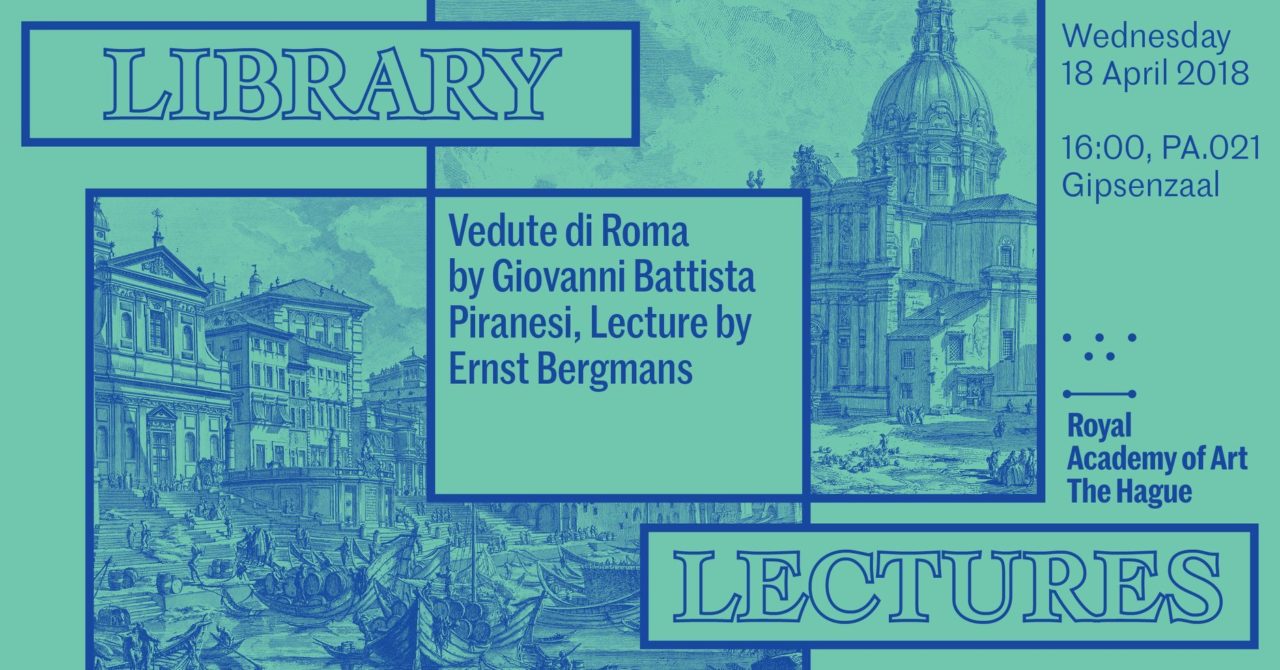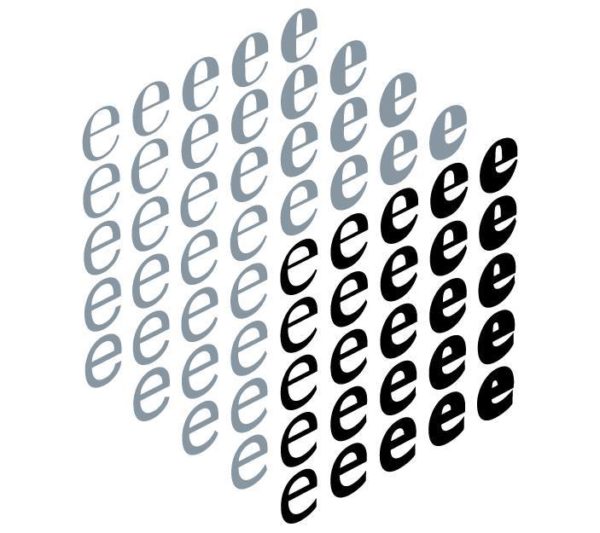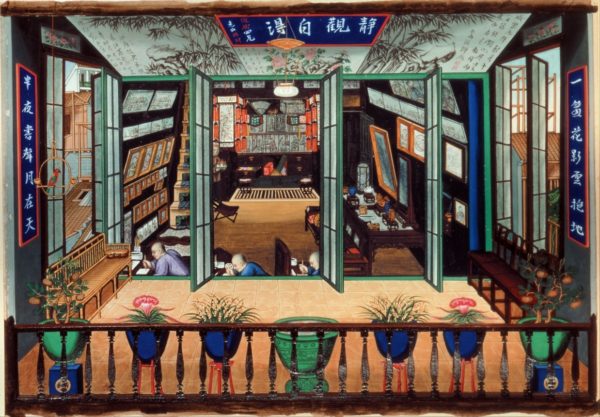On 18 April 2018 Ernst Bergmans presented a Library Lecture on the topic of the ‘Vedute di Roma’ by Piranesi
Vedute di Roma, Giovanni Battista Piranesi
‘Rome in ruins is a symbol of a lost world; the emotional impact is intense’
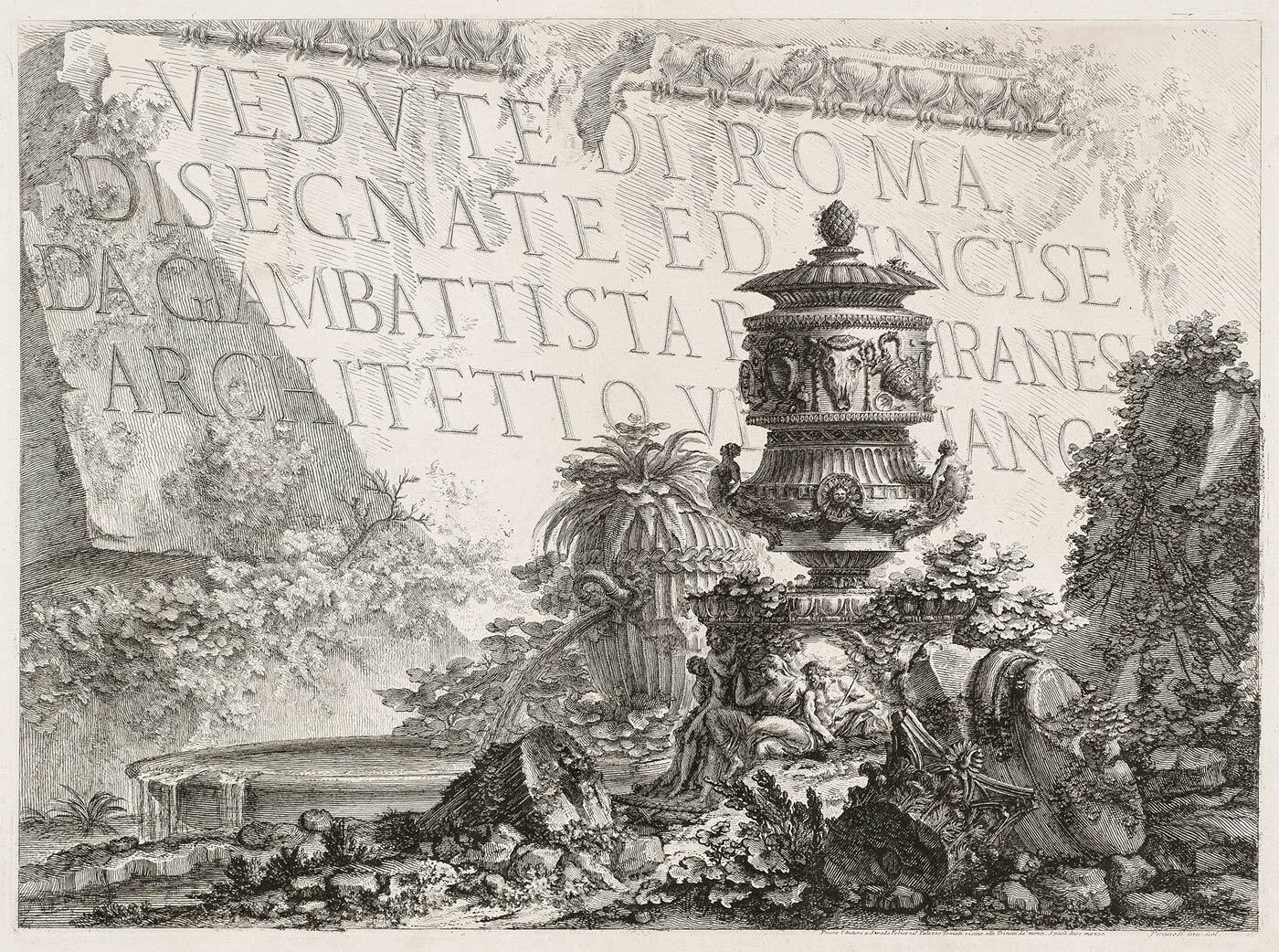
Favourite hidden treasure
During my last years at the Academy I was involved in the research of the remaining fragments from ‘former art collections’ of KABK. And therefore, I also browsed through the antiquarian collection of KABK Library.
Among them are 120 etchings of the Vedute di Roma (Views on Rome) by Giovanni Battista Piranesi (1720-1778). This hidden treasure is one of my favourite pieces of the KABK Library collection.
Being a printmaker myself I felt privileged to have a closer look into this brilliant collection, to establish a ‘sort of’ chronological inventory to rank the prints in the correct order. All prints are numbered in pencil on the rear side of the printing paper – probably by the former librarian –, but there appears to be no logical reason for this particular numeral order. I made an inventory of the prints and linked orderings from different sources together with the pencil numbering.*
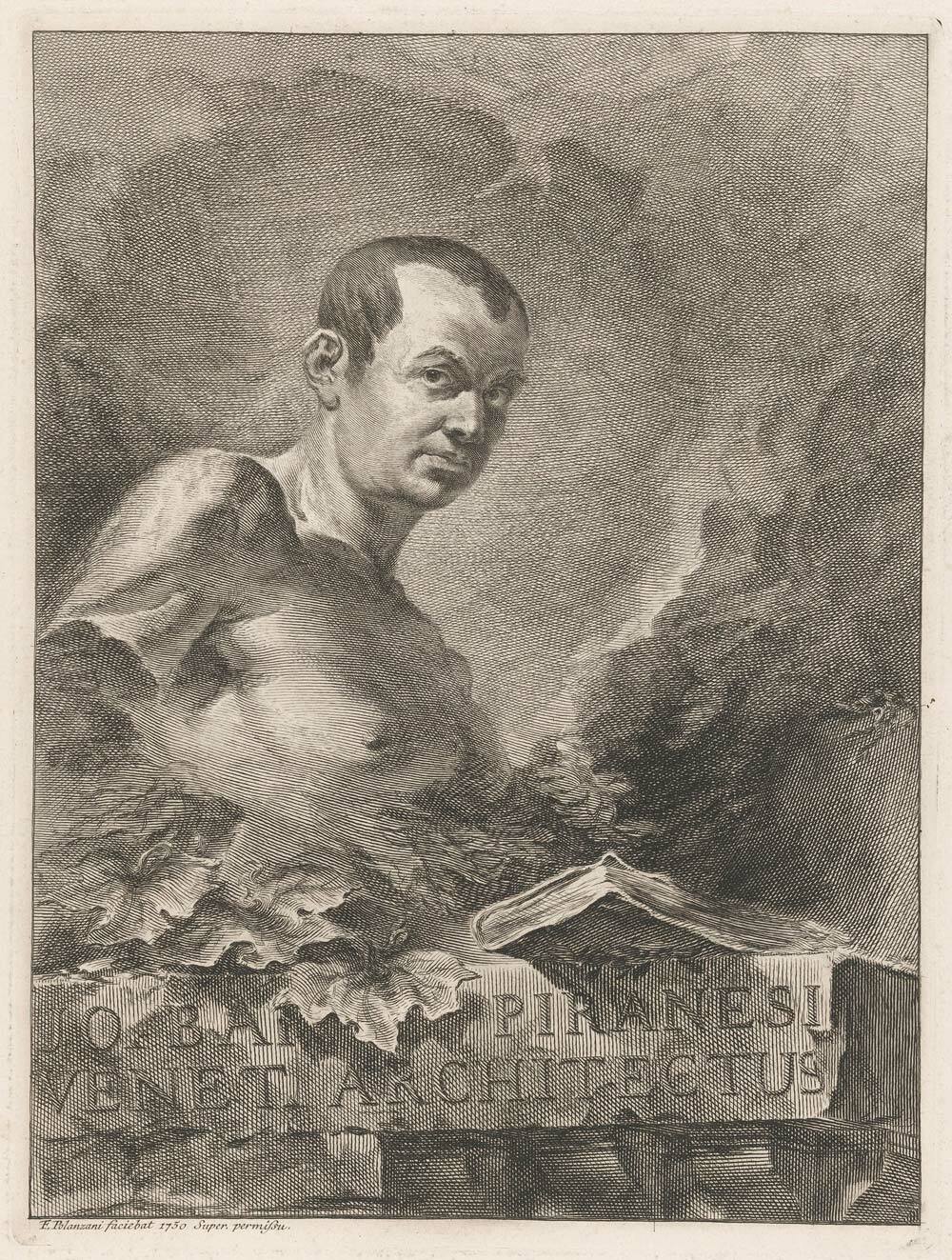
‘I need to produce great ideas…’
Piranesi was born in 1720 in Mogliano, a small town in the Repubblica di Venezia. His father was a stonemason and his uncle was an architect and responsible for the constructions that defended Venice against the sea.
As Piranesi grew older he turned out to be an incredible character, a polemic thinker, artist and print maker, designer, archaeologist and above all ‘Architetto Veneziano’. An architect who at the age of forty still had to build his first building...
Illustrative of Piranesi’s ambitions is a quote recorded by one of his early biographers:
‘I need to produce great ideas, and I believe that if I were commissioned to design a new universe, I would be mad enough to undertake it’
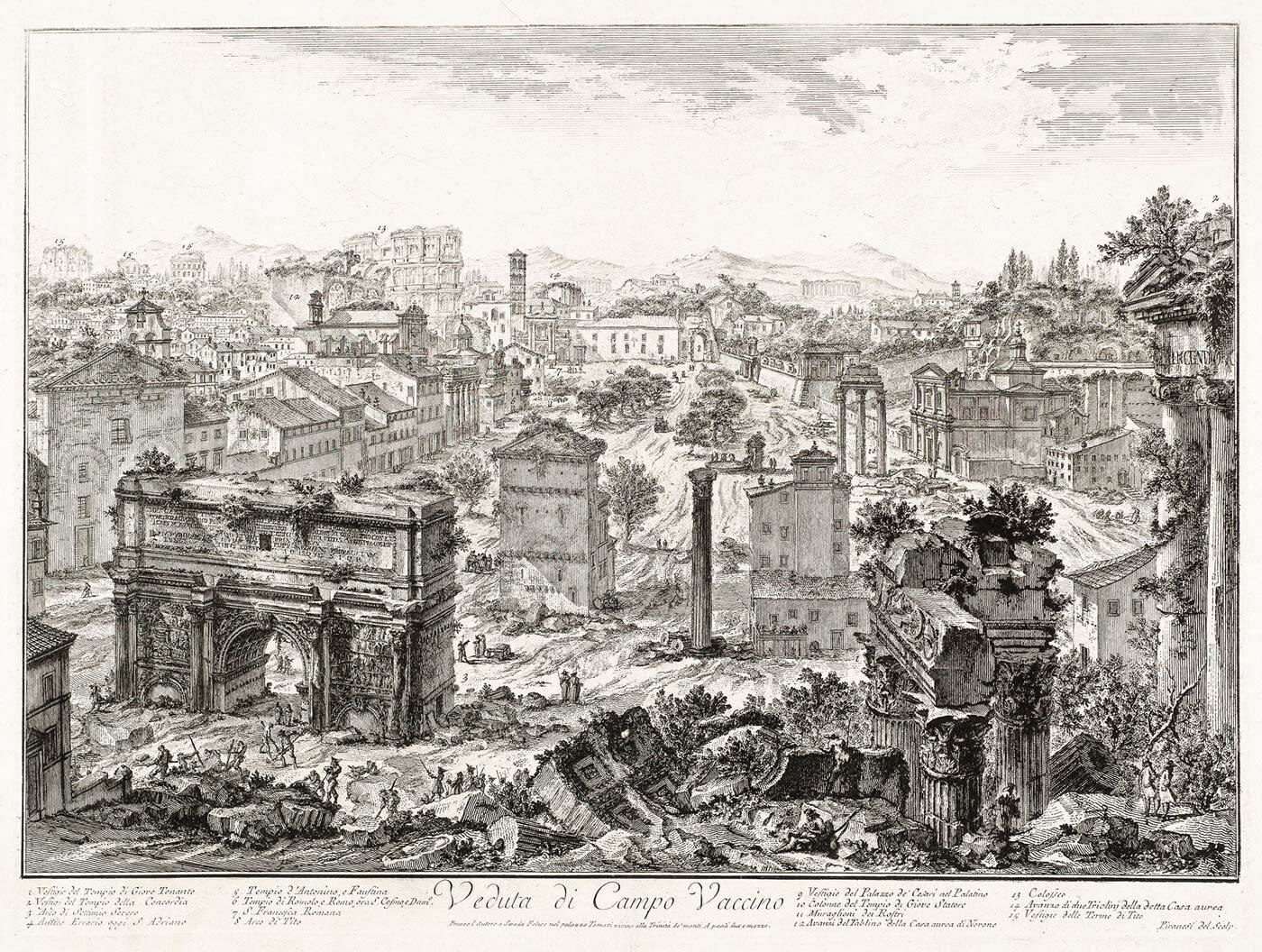
Apprentice print maker
Piranesi must have been a talented young man, because at the age of twenty he was invited as a draftsman by the Venetian ambassador Marco Foscarini (1696-1763) to join his entourage to visit the new Pope Benedict XIV (r. 1726- 1758).
When he arrived in Rome, he was overwhelmed by the majestic ecclesiastical city and the archaeological artefacts which he saw in the newly opened archaeological Capitoline Museum. But he was even more taken by the remains of the imperial architecture.
Soon after his arrival in Rome he became an apprentice at the print workshop of Giuseppe Vasi (1710-1782). In these days Vasi was the most important engraver of the popular ‘Vedute’ prints and worked for German and French publishers.
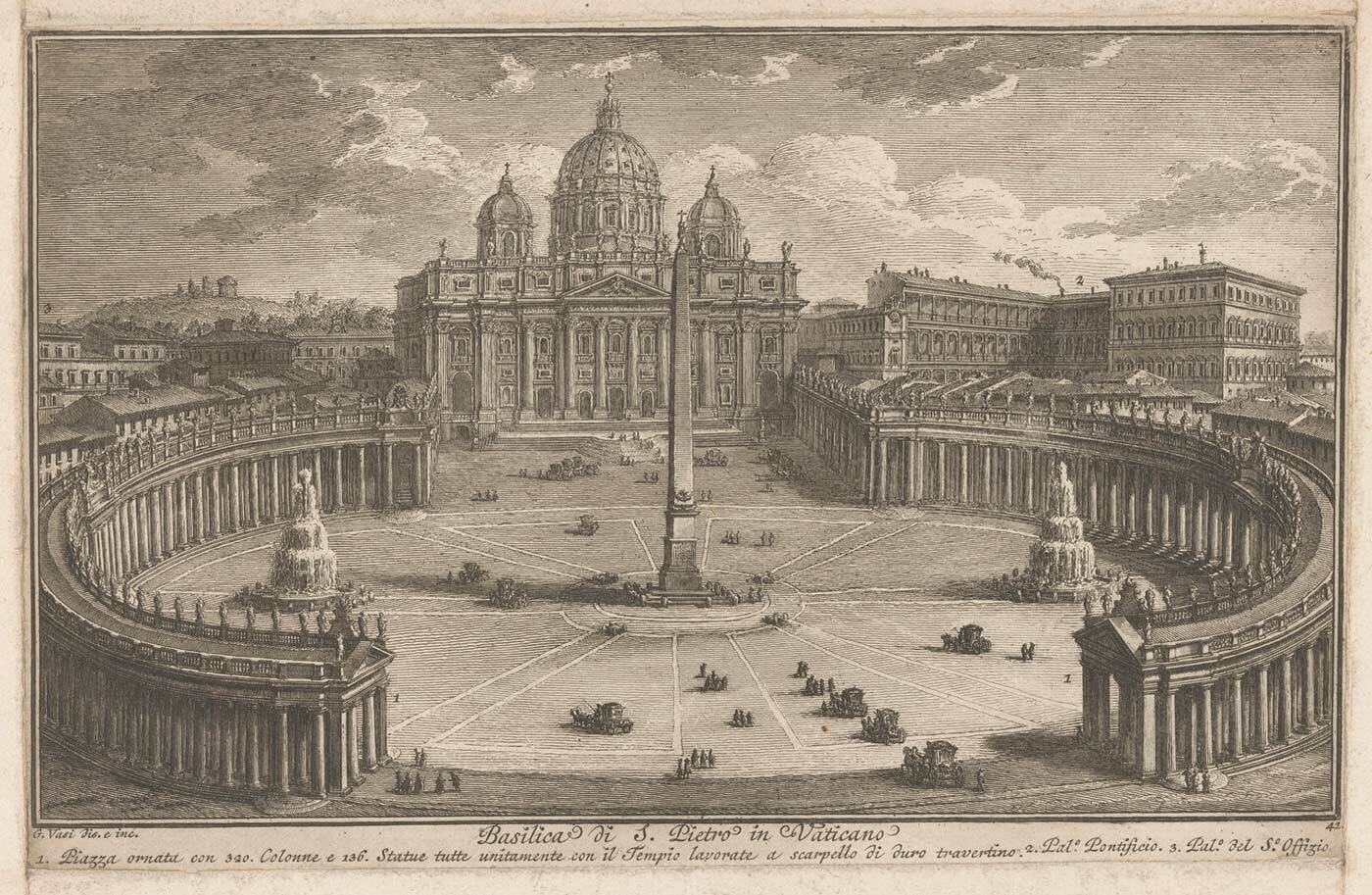
Financial difficulties
Because his father was unable to continue his allowance, Piranesi had to return to Venice (Hind, 1922). Just before Piranesi left Rome, he visited the excavations in Herculaneum and Pompeii. This journey must have had a big influence on his affection for archaeology in the remains of a once great empire.
It seems inevitable that Piranesi became acquainted with a large number of Venetian artists like Visentini (1688-1782) who made engravings from the drawings and paintings of Canaletto (1697-1768) and Tiepolo (1696-1770) at whose studio he further immersed himself in painting.

Return to Rome
Piranesi was encouraged to return to Rome by Guiseppe Wagner (1706-1770), a successful engraver and publisher of Venice who helped him to set up a shop in the Via del Corso opposite to the Palazzo Mancini where at that time the French Academy was situated.
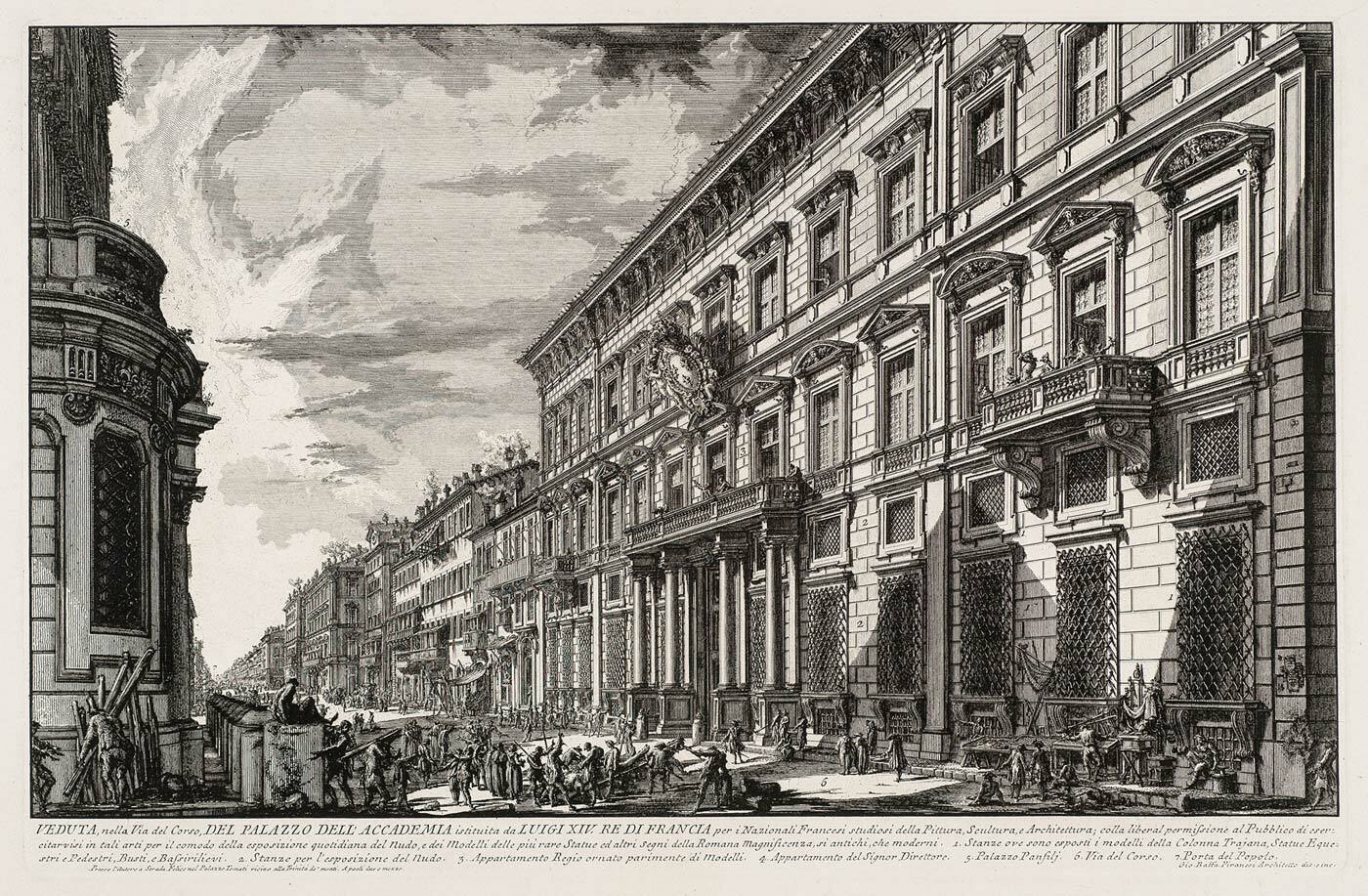
This French Academy was founded by King Louis XIV (1638-1715) in 1666. French artists and architects who had won the Grand Prix de Rome could remain there to work and study.
During his previous stay in Rome, Piranesi had already been closely affiliated with the residents of this Academy. From Piranesi’s writings we can learn that he shared their enthusiasm for antiquity and their radical theories following the merits of the age of the enlightenment.
However, he resented the ideas of his French neighbours, chiefly that the Roman architectural and constructional achievements were largely due to Greek influence.
Piranesi was strongly opposed to this point of view. In his Lettere di giustificazione (1757), he argued that Roman Imperial architecture was primarily based on Etruscan and Egyptian principals, neglecting the minor detail that, beside the evident Greek influence, most buildings and statues in Rome were largely made by Greek workers (Wilton-Ely, 1978).
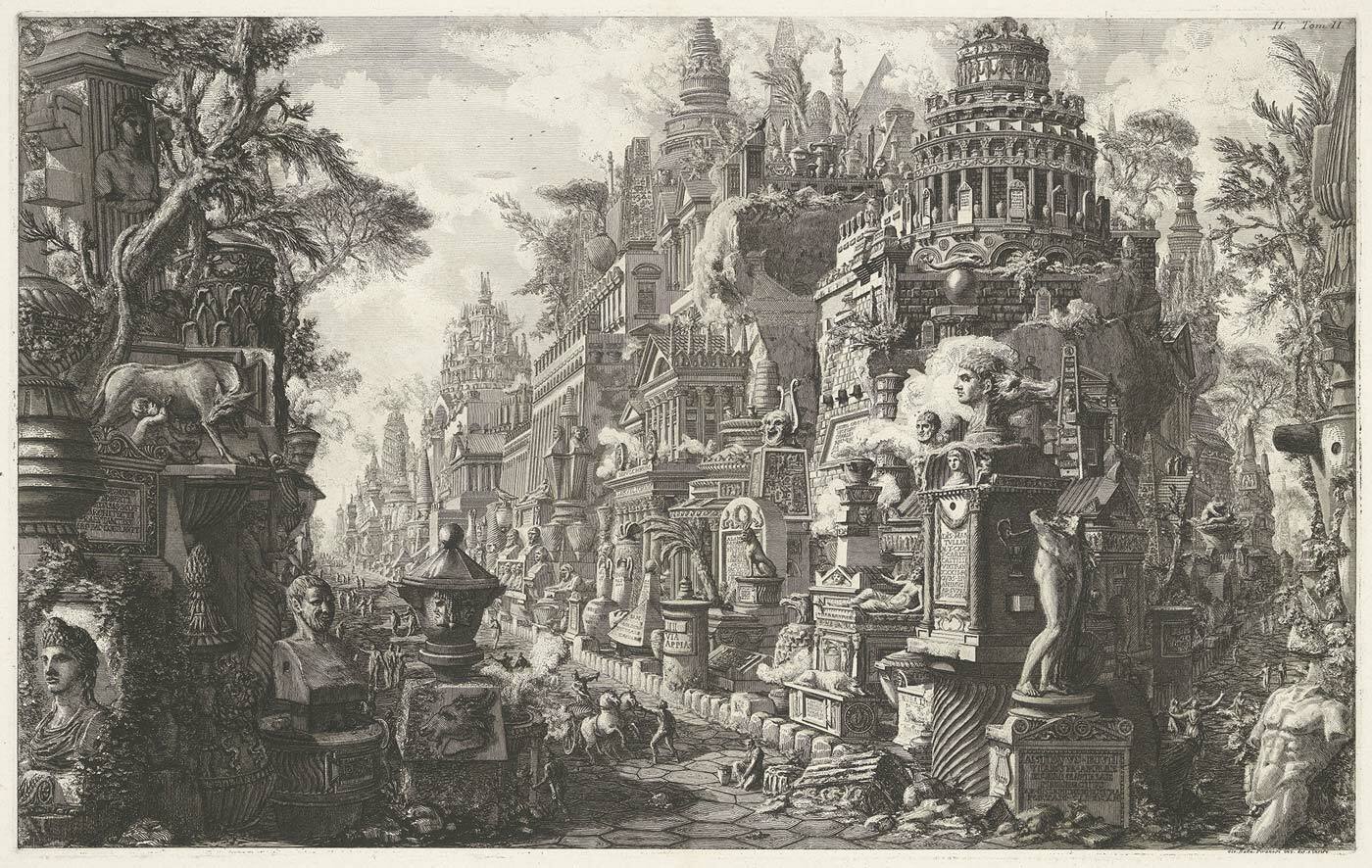
Le Antichità Romane (1756)
During his first years in Rome, Piranesi developed into a dedicated archaeologist and above all a passionate protector of the countless ancient ruins.
‘Seeing that the ruins of Rome’s antique buildings, mostly scattered throughout the vegetable gardens […], are diminishing […] either because of the contempt of the past, or because of the avarice of the owners, who with barbaric license […] sell the fragments for the use of constructing modern buildings, I have warned myself to keep them by means of prints.’
Piranesi succeeded in convincing Pope Clement XIII (r. 1758-1769) of the great significance of the neglected ruins and how they could become an important element in the development of Rome. The Pope became a major patron for Piranesi’s Magnum Opus: Le Antichità Romane (1756), containing two hundred and fifty etchings about Piranesi’s archaeological researches in Rome. This extensive work earned him an international reputation. Piranesi had changed the perception of ancient times and even today his contribution is of great influence.
The Vedute genre

At the end of the Renaissance, European engravers produced large editions of city views and landscapes, with refined topographical accuracy, to meet the demands of foreign visitors to Rome. Of course, ‘the Grand tour’ was a strong stimulus for this production and trade of printed images. Around 1660–1820, in Europe this ‘Tour’ was considered to be the best way to complete a gentleman’s education. Their most popular destinations were the important cultural places in Europe, along with the remains of ancient Roman and Greek civilization.
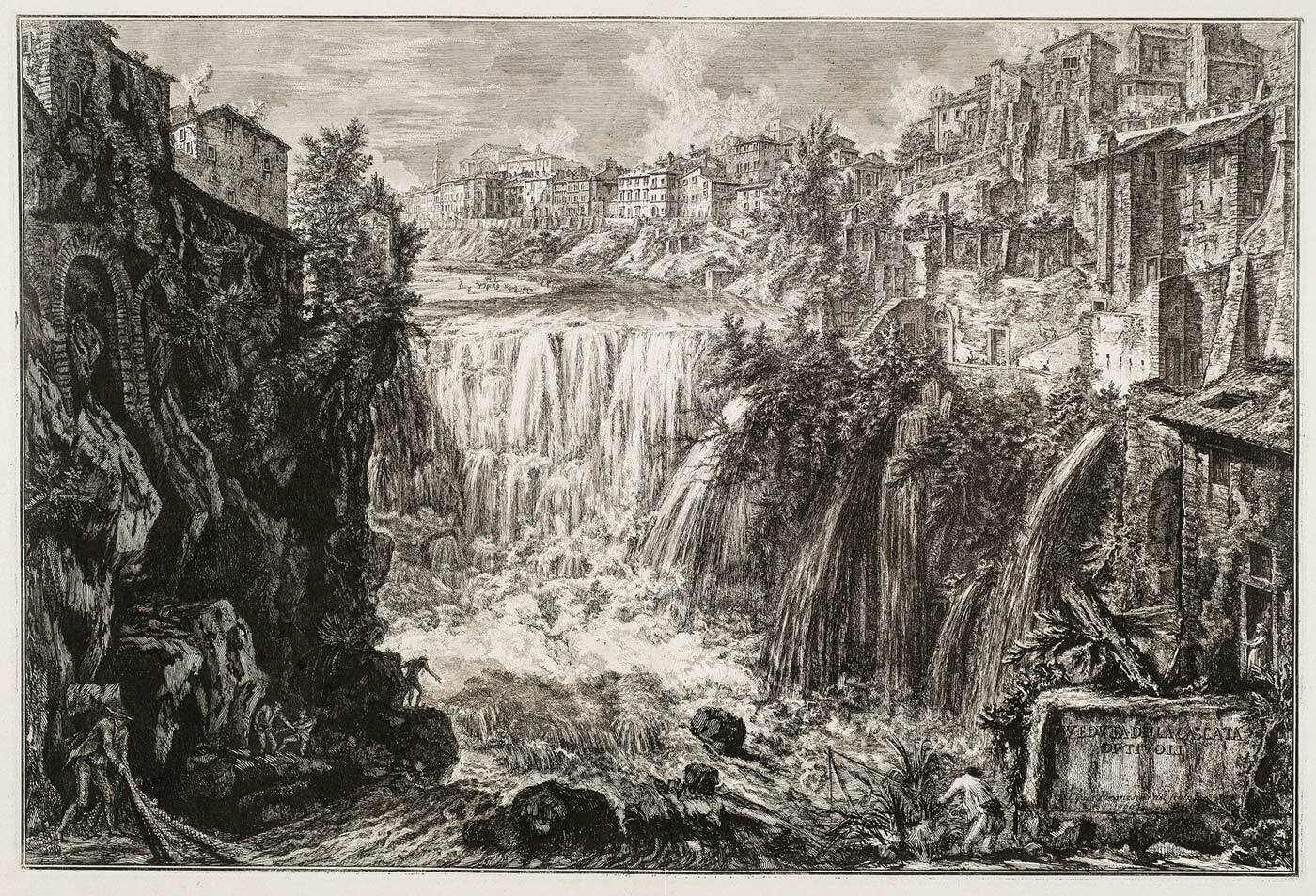
Vedute di Roma
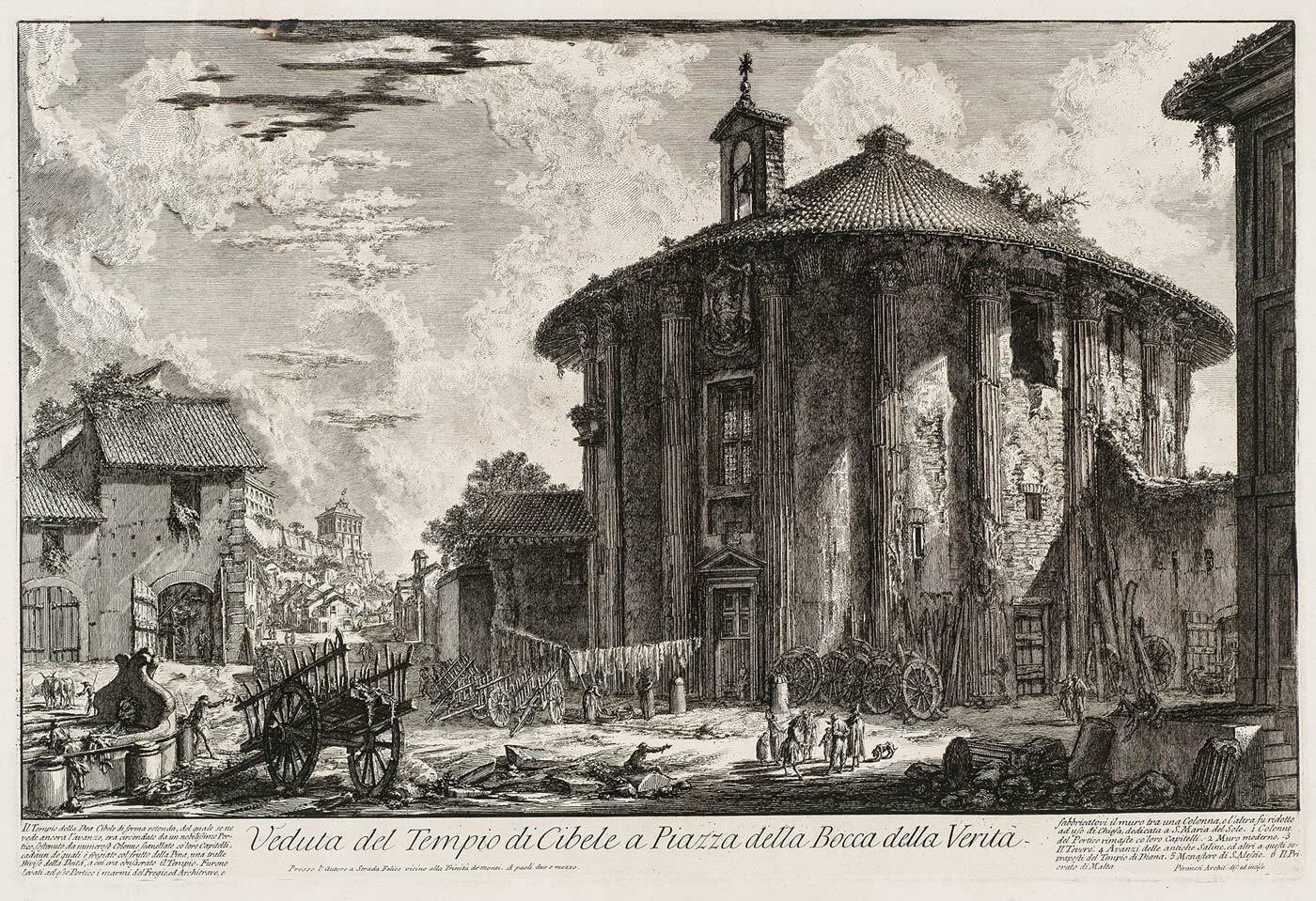
In the background of the above-added print you can see the monastery Priorato di Malta on the Aventine. Piranesi is buried in this monastery’s church. These monastery and church are the only buildings ‘Architetto Piranesi’ would ever realise.
Throughout his life Piranesi worked on the ‘Vedute’, carefully choosing his subjects, often depicting the old ruins as a juxtaposition to the contemporary architecture of his time.
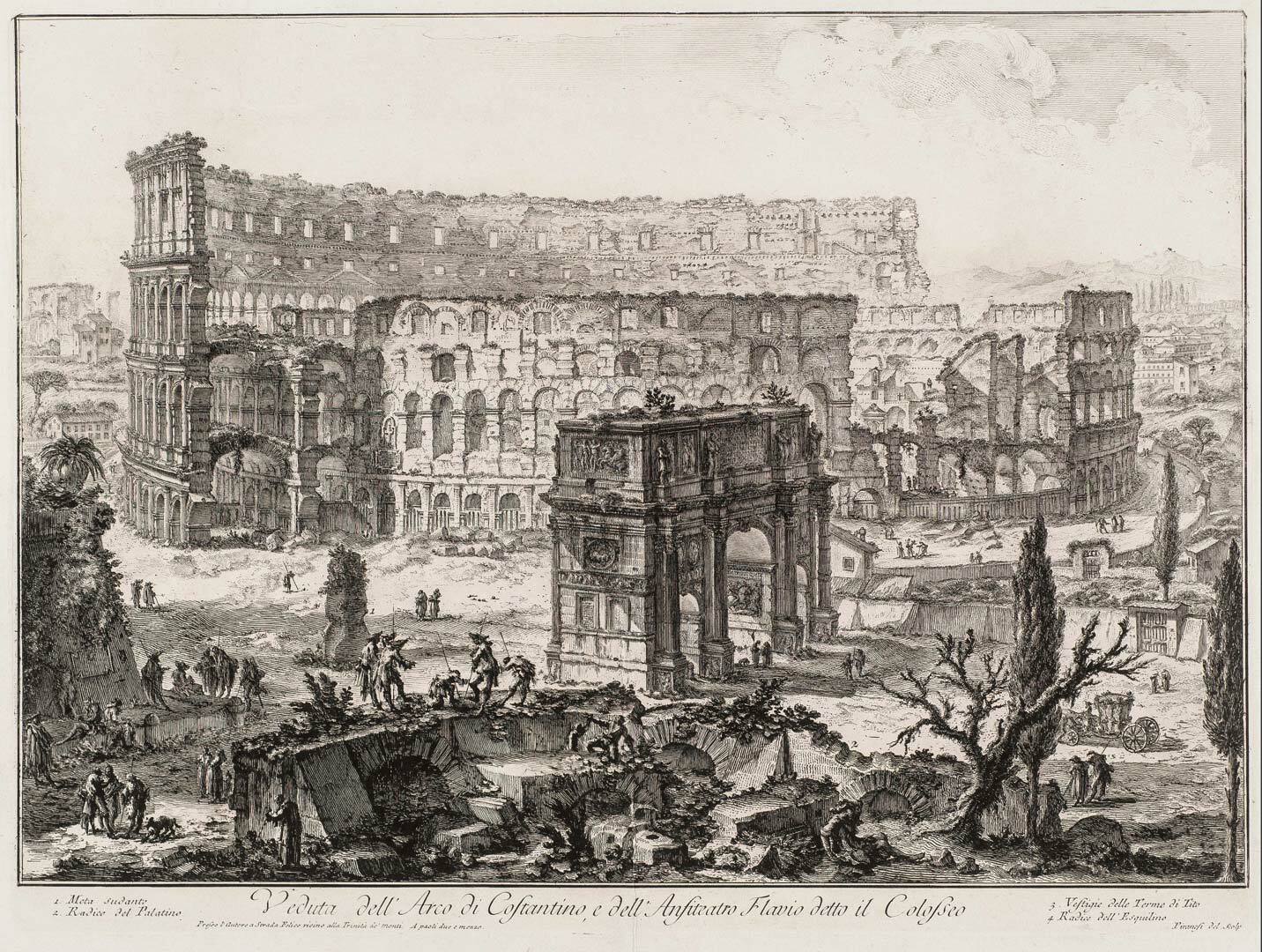
Everything that Piranesi invented, designed or wrote was etched in copper plates. This was a common way at the time to reproduce texts and images.
The lifelong production of the ´Vedute di Roma´ was mainly a commercial matter for Piranesi. Where the etched image, to use his words, became ‘magnificent’ was in how he managed to apply the technique of line etching almost in the same way a painter paints.
Legrand wrote about this aspect:
‘ [Piranesi] was used to draw in the hardened etching ground […]. He covered the whole plate with these lines, very cleverly minding the composition, and the thickness varying according to the depth of the shades […]. Only after the preparatory work was done, the light effects were covered with a brush dipped in varnish […]. This broad approach replaced the mechanical precision sometimes found on conventional engravings... [see the example of De Leth’s view on Amsterdam, EB]. Then he started etching […], treating the shadows one by one, which process could be repeated ten to twelve times on some plates...’
Piranesi eventually ran a workshop with about sixty workers. In addition to making prints, there was a large production of candlesticks, mantelpieces and sculptures composed of antique fragments.
It is clear that Piranesi left the printing of the editions to printers. But he (usually) made the etchings himself by working directly on the plate; in mirror image off course. He didn’t like to make elaborate sketches because the image would become a copy and his objective was to create an original image.
‘[Around 1743-1760] Piranesi began to use dry point, engraving, etching, rubbing and burnishing together. And in [a later] edition of the Carceri, [he] added ink dabbing with his hands and with a rag to the copper plates in order to make his etchings look more spontaneous and to obtain a deeper black colour in the shadows.’
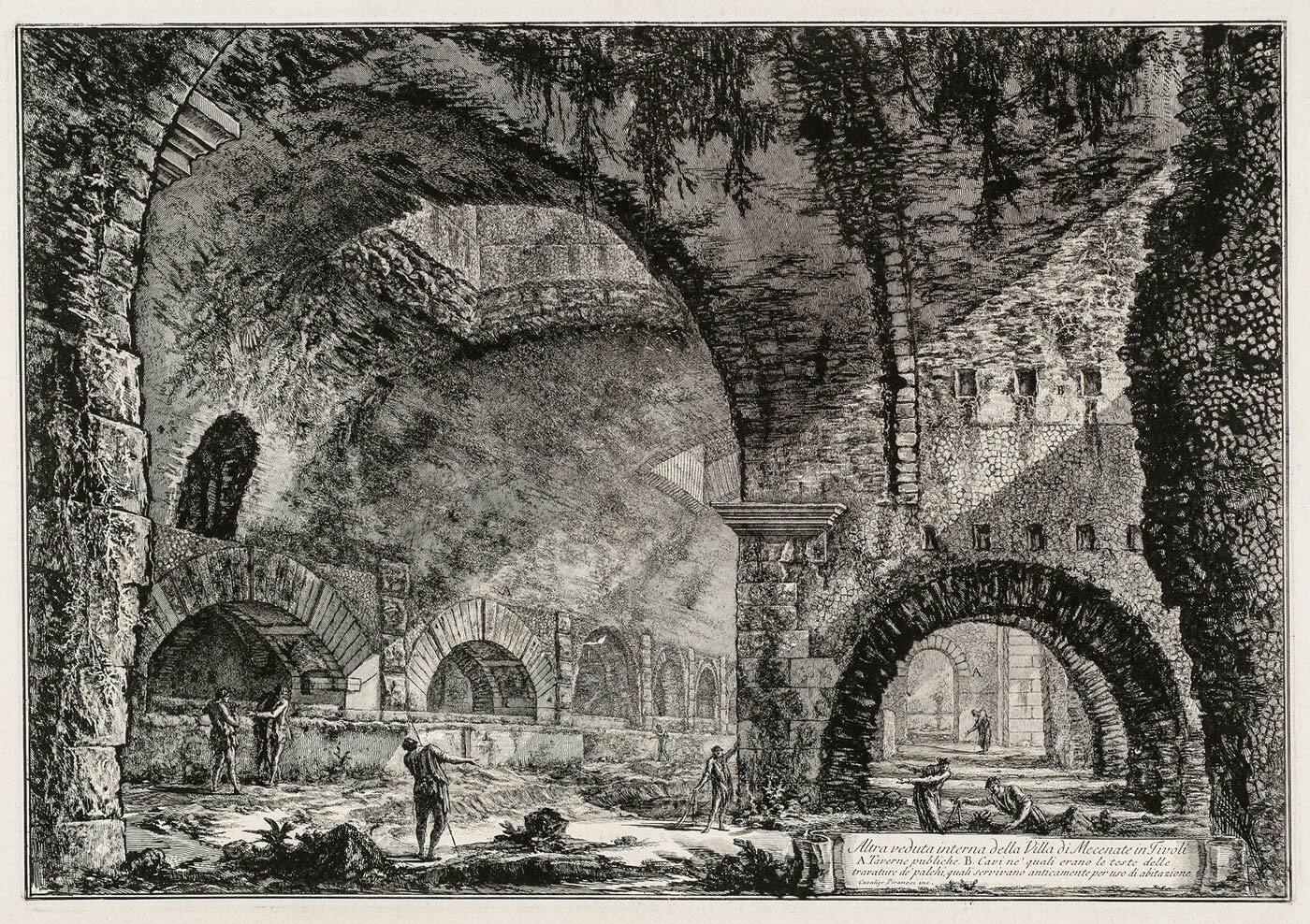
His unique craftsmanship enables him to accomplish his passionate mission to merge ancient Rome with the contemporary city. He depicted the cityscapes, populated with mysterious figures as a stage design, a scenography in which he played with perspective, scale and chiaroscuro. In many of his prints he represented the buildings much larger than they actually were. Compared to their size, the scale of the figures is often ridiculously small. If we should believe Piranesi, every inhabitant of Rome was an active archaeologist, carefully digging and studying the dug-up artefacts. Looking closely at Piranesi’s ‘Vedute’ will colour your romantic imaginary representation of Rome.
After Piranesi’s death his son Francesco took the etching plates to Paris. He added ‘Pianta di Roma e del Campo Marzo’ to the Roman Vedute series. This ‘pianta’ was a large engraved map of Rome, made by his father. The map refers to the sites illustrated in the series Antichità Romane. Later on, the entire estate was bought by the famous French publisher Firmin Didot (1764-1836) who continued to issue Piranesi’s hundred and thirty-five Vedute-prints. The Paris edition of the complete ‘Vedute di Roma’ could be acquired in two folders.
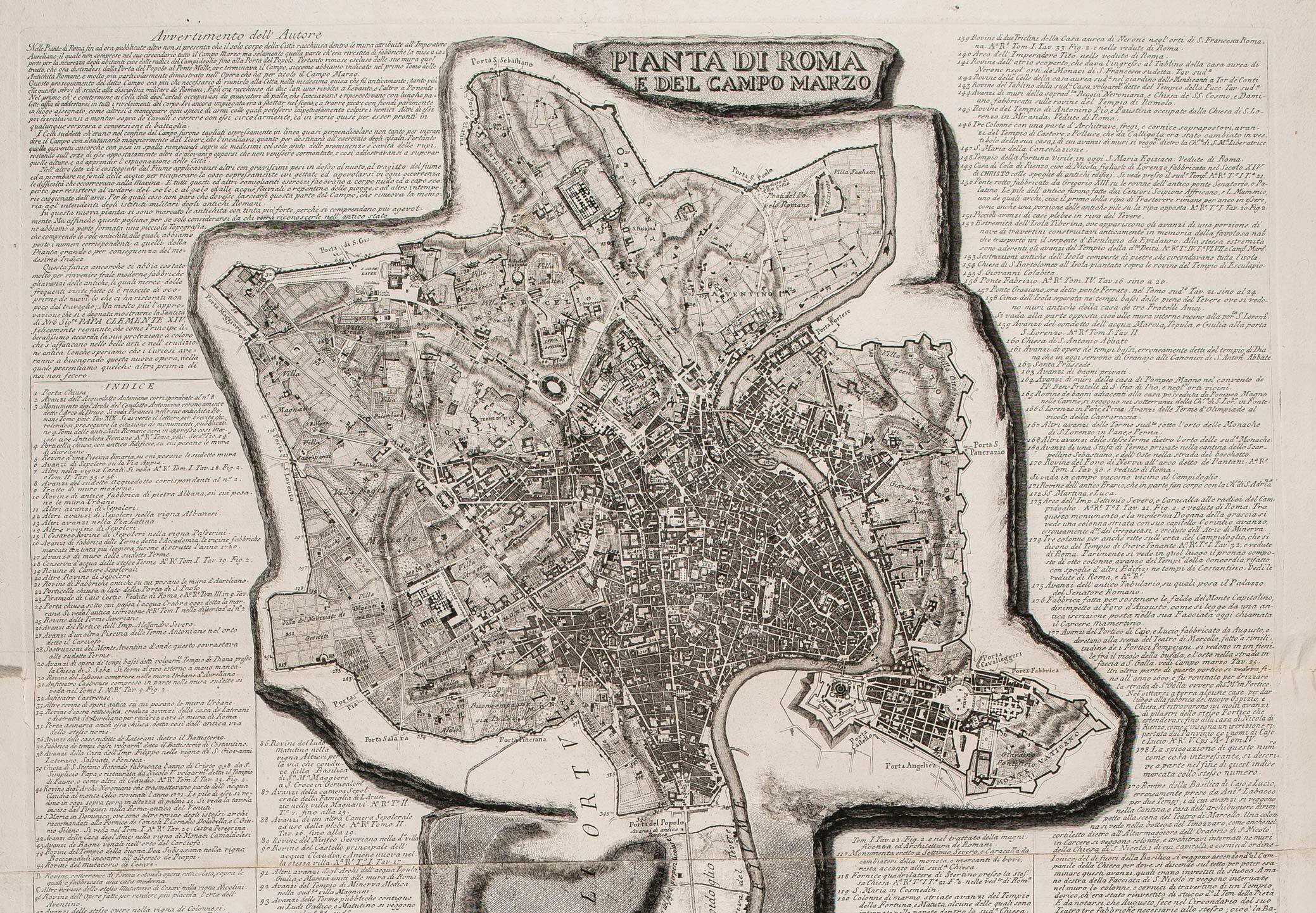
In 1761 Piranesi moved to the Palazzo Tomati in the Strada Felice (nowadays Via Sistina) in Rome and started to publish and sell his prints independently. Following Hind’s analyses in his critical study regarding dating Piranesi’s Vedute, it is most likely that the library's Piranesi’s were printed and published between 1761 and 1776. Over fifty KABK-library prints have Piranesi’s new address and the price, etched in the lower margins. After Piranesi’s death in 1778, the address was removed from the plates (Hind, 1922).
I knew of these prints while I was a teacher at KABK. Colleagues used to show them to their students during class, but nowadays there aren’t that many people who know about them. I feel privileged that I can offer these etchings the attention they deserve, so that present and future students and teachers know about them, and can enjoy and cherish this library treasure as much as I always did.
We still don’t know when the Academy acquired these prints and who were involved. Maybe someday we will find out but so far this remains a small mystery.
Notes
*Apart from the printed lists of items for sale by the Piranesi workshop, there are four slightly different catalogues of the ‘Vedute di Roma’: respectively compiled by Focillon, Wilton-Ely, Hind and Ficacci. In my inventory of the library prints I linked them together and integrated the pencil numbering as well. We chose the Luigi Ficacci order as our reference. Piranesi. The Complete Etchings (Ficacci, 2000) is available in KABK library collection.
Many thanks to KABK alumna Louise Harley for reading and correcting the English text.
Ficacci, Luigi, Piranesi. The Complete Etchings. Köln: Benedikt Taschen, 2000.
Focillon, Henri, Giovanni-Battista Piranesi, 1720-1778. Paris: H. Laurens, 1918.
Hind, Arthur M., Giovanni Battista Piranesi : a critical study, with a list of his published works and detailed catalogues of the prisons and the views of Rome. New York: E. Weyhe, 1922.
Legrand, Jacques Guillaume, Notice sur la vie et des ouvrages de J.B.Piranesi, [Paris: 1799].
Macaulay, Rose, The pleasure of Ruins, London: Weidenfeld and Nicolson, 1953.
Rosenfeld, Myra Nan, Picturesque to Sublime: Piranesi's Stylistic and Technical Development from 1740 to 1761,2006.
Thompson, Wendy. ‘Giovanni Battista Piranesi (1720–1778)’. In Heilbrunn Timeline of Art History. New York: The Metropolitan Museum of Art, 2000–.
Wilton-Ely, John, Giovanni Battista Piranesi. Zijn visie en zijn werk. Amsterdam: Meulenhoff, 1978.
Personalia

Ernst Bergmans
Ernst Bergmans spoke about Piranesi’s ‘Vedute’ during his Library Lecture on 18 April 2018. Ernst studied at the Rijks Academie van Beeldende Kunsten (Amsterdam) and at the Royal Academy of Art (KABK, The Hague). In the service of the KABK, he held several positions, including that of lecturer, head of several departments and construction coordinator. Since 2018 Ernst is retired after having been associated with the KABK for more than forty years. He’s still active in advising the board about several restorations of the monumental academy building and is a member of the Exam Committee of the Royal Conservatoire.
